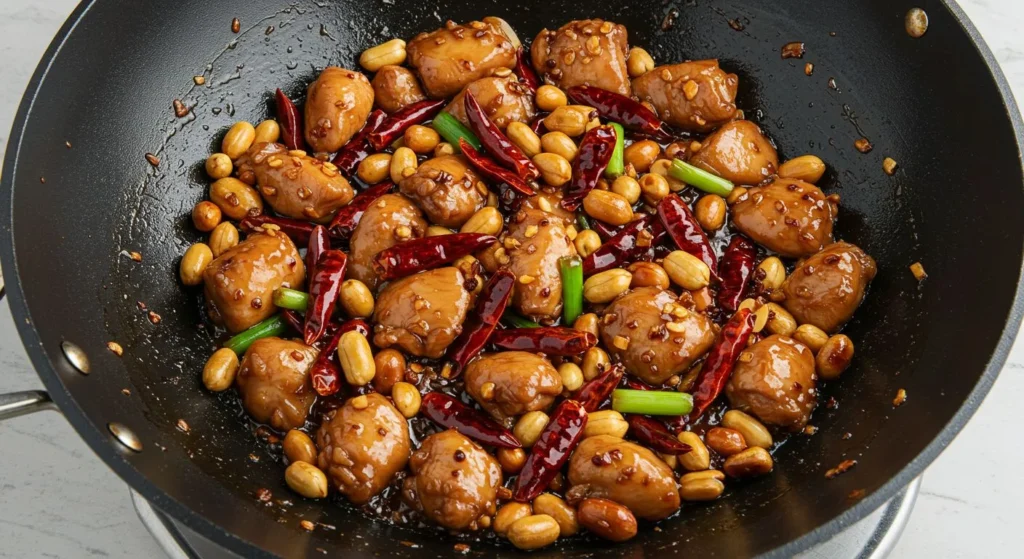
Table of Contents
Introduction: The Story Behind the Legendary Kung Pao Chicken
Kung Pao Chicken (宫保鸡丁, Gōngbǎo Jīdīng) stands as one of Chinese cuisine’s most celebrated dishes, renowned for its perfect balance of flavors and textures. This iconic Sichuan delicacy combines tender chicken pieces with roasted peanuts, vegetables, and dried chilies, all brought together in a deliciously complex sauce that delivers the characteristic “málà” (numbing and spicy) sensation that Sichuan cuisine is famous for.
The dish’s fascinating history dates back to the Qing Dynasty, where it was reportedly created by and named after a government official, Ding Baozhen (1820-1886), who served as governor of Sichuan Province. Gong Bao (Kung Pao) was his official title, meaning “Palace Guardian,” and the dish that became associated with him has endured as a testament to his legacy. Over the centuries, this remarkable dish has traveled beyond China’s borders to become a staple on Chinese restaurant menus worldwide, though often adapted and simplified for international palates.
In this comprehensive guide, we’ll take you through everything you need to know to create an authentic Kung Pao Chicken experience in your own kitchen. From selecting the finest ingredients to mastering the precise cooking techniques that bring this dish to life, you’ll learn how the perfect Kung Pao Chicken should taste: spicy, tangy, slightly sweet, with a complexity that keeps you coming back for more.
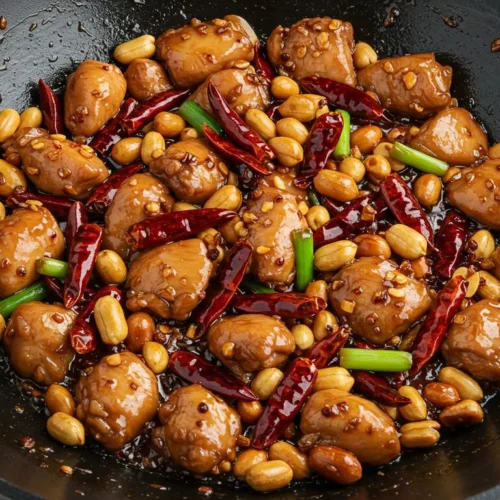
Authentic Kung Pao Chicken
Ingredients
- 1½ pounds boneless skinless chicken breasts
- 1 tablespoon Shaoxing wine
- 1 tablespoon light soy sauce
- 1 teaspoon white pepper
- 1 teaspoon cornstarch
- ½ teaspoon salt
- 3 tablespoons light soy sauce
- 2 tablespoons Chinese black vinegar
- 2 tablespoons chicken stock
- 2 tablespoons Chinese rice wine
- 1 tablespoon dark soy sauce
- 1 tablespoon sugar
- 1 teaspoon cornstarch
- ½ teaspoon ground Sichuan pepper
- 3 tablespoons vegetable oil
- 10-15 dried red chilies
- 2 teaspoons Sichuan peppercorns
- 4 cloves garlic
- 1- inch piece ginger
- 5 green onions
- ½ cup unsalted roasted peanuts
- 1 red bell pepper optional
- 2 stalks celery optional
What Makes Authentic Kung Pao Chicken Special?
Before diving into the ingredients and preparation, it’s important to understand what distinguishes truly authentic Kung Pao Chicken from westernized versions. The original Sichuan preparation emphasizes several key elements:
- The Málà Experience: Authentic Kung Pao delivers the distinctive numbing-spicy sensation through the use of Sichuan peppercorns and dried chilies.
- Texture Contrast: The dish masterfully balances the tenderness of marinated chicken with the crunch of roasted peanuts and the slight chew of dried chilies.
- Flavor Complexity: Rather than being simply “spicy,” true Kung Pao Chicken presents layers of flavor – aromatic, spicy, sweet, sour, and savory notes working in harmony.
- Restrained Sauce: Unlike many westernized versions swimming in sauce, authentic Kung Pao features just enough sauce to coat the ingredients while maintaining their distinct textures.
- Precision Cooking: The stir-frying process requires precise timing and temperature control to achieve the perfect outcome.
Now, let’s gather everything we need to create this culinary masterpiece at home.
Ingredients: The Building Blocks of Perfect Kung Pao Chicken
For the Chicken Marinade:
- 1½ pounds (680g) boneless, skinless chicken breasts or thighs, cut into ¾-inch cubes
- 1 tablespoon Shaoxing wine (Chinese rice wine)
- 1 tablespoon light soy sauce
- 1 teaspoon white pepper
- 1 teaspoon cornstarch
- ½ teaspoon salt
For the Sauce:
- 3 tablespoons light soy sauce
- 2 tablespoons Chinese black vinegar (Chinkiang vinegar)
- 2 tablespoons chicken stock or water
- 2 tablespoons Chinese rice wine (Shaoxing wine)
- 1 tablespoon dark soy sauce (for color)
- 1 tablespoon sugar
- 1 teaspoon cornstarch
- ½ teaspoon ground Sichuan pepper
For the Stir-Fry:
- 3 tablespoons vegetable oil, divided
- 10-15 dried red chilies (preferably Sichuan facing heaven chilies), cut in half and seeds removed for less heat
- 2 teaspoons Sichuan peppercorns
- 4 cloves garlic, minced
- 1-inch piece ginger, minced (about 1 tablespoon)
- 5 green onions, white parts only, chopped into small rounds
- ½ cup unsalted roasted peanuts
- 1 red bell pepper, diced into ¾-inch squares (optional for color, not traditional)
- 2 stalks celery, diced into ¾-inch pieces (optional, not traditional)
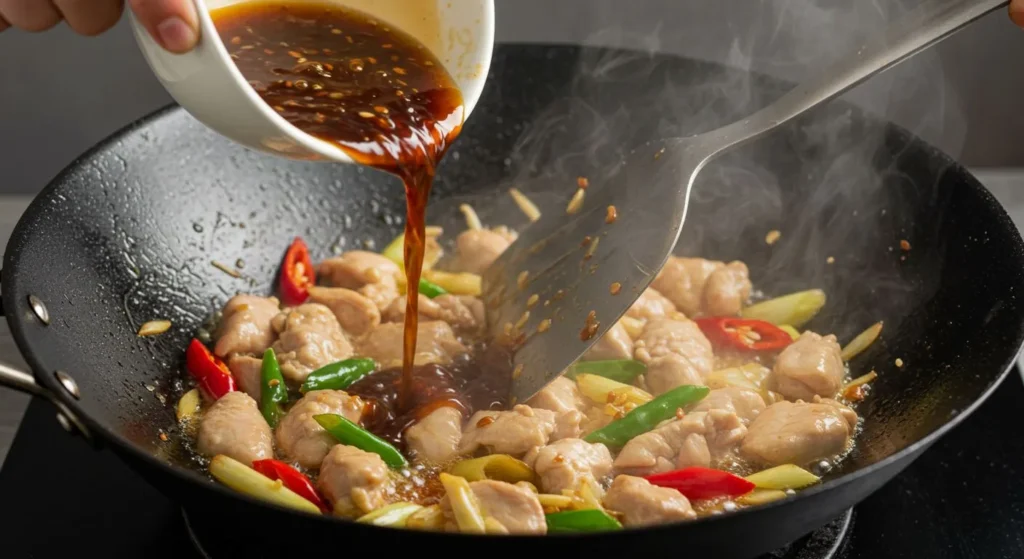
Equipment You’ll Need
- Wok or large frying pan
- Sharp knife and cutting board
- Small bowls for prepared ingredients
- Measuring spoons and cups
- Wok spatula or wooden spoon
- Mixing bowl for marinating chicken
Step-by-Step Preparation Method
Step 1: Prepare and Marinate the Chicken
The foundation of excellent Kung Pao Chicken begins with properly prepared and marinated chicken:
- Ensure your chicken is very dry by patting it thoroughly with paper towels. This is crucial for achieving a good sear rather than steaming the meat.
- Cut the chicken into uniform ¾-inch cubes. Consistency in size ensures even cooking.
- In a medium bowl, combine the chicken with Shaoxing wine, light soy sauce, white pepper, cornstarch, and salt.
- Mix thoroughly until every piece is evenly coated.
- Let the chicken marinate for at least 20 minutes at room temperature, or up to 2 hours in the refrigerator. This process not only adds flavor but also tenderizes the meat.
The cornstarch in the marinade creates a protective coating that helps prevent the chicken from overcooking and keeps it juicy during the high-heat stir-frying process.
Step 2: Prepare the Sauce
The distinctive sauce is what gives Kung Pao Chicken its complex flavor profile:
- In a small bowl, combine light soy sauce, Chinese black vinegar, chicken stock, Shaoxing wine, dark soy sauce, sugar, cornstarch, and ground Sichuan pepper.
- Whisk thoroughly until the cornstarch and sugar are completely dissolved.
- Set aside. The sauce ingredients will separate naturally as they sit, so give them another quick stir right before adding to the wok.
This balanced sauce brings together salty, sweet, tangy, and aromatic elements that characterize Sichuan cuisine. The cornstarch will thicken the sauce just enough to coat the ingredients without becoming gloopy.
Step 3: Prepare All Other Ingredients
Stir-frying happens quickly, so having everything ready before you start cooking is essential:
- Cut the dried chilies in half and shake out some or all of the seeds depending on your heat preference. For an authentic experience, leave some seeds in.
- Mince the garlic and ginger finely and set aside together.
- Chop the white parts of the green onions into small rounds.
- If using bell pepper and celery, dice them into ¾-inch pieces.
- Measure out the Sichuan peppercorns and peanuts.
- Arrange all prepared ingredients in small bowls near your cooking area for easy access during the fast-paced stir-frying process.
This mise en place (everything in place) approach is crucial for successful stir-frying, where timing is critical and there’s no opportunity to prepare ingredients once cooking begins.
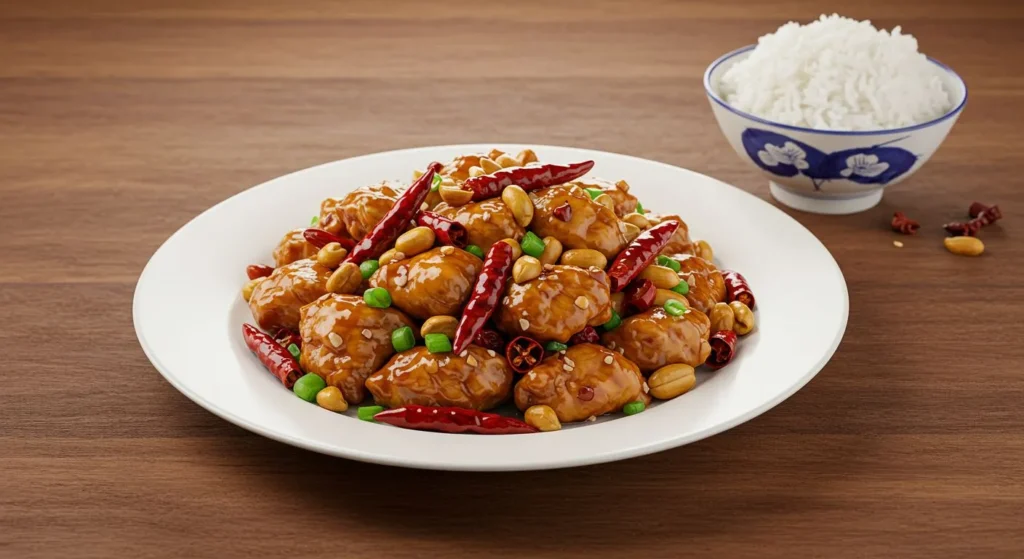
Step 4: The Stir-Frying Process
Now comes the most critical part – the actual cooking process that brings all elements together:
- Heat your wok or large frying pan over high heat until it begins to smoke slightly.
- Add 2 tablespoons of vegetable oil and swirl to coat the cooking surface.
- When the oil is shimmering hot, add the marinated chicken pieces, spreading them out in a single layer.
- Let the chicken sear undisturbed for 30 seconds before stir-frying for another 2-3 minutes until the pieces are just cooked through with some golden edges. Be careful not to overcook.
- Remove the chicken from the wok and set aside.
- Reduce heat to medium-high and add the remaining tablespoon of oil to the wok.
- Add the dried chilies and Sichuan peppercorns, stir-frying for about 30 seconds until the chilies darken slightly and become aromatic. Be careful not to burn them, as this will create an unpleasant bitterness.
- Quickly add the minced garlic, ginger, and white parts of green onions, stir-frying for another 30 seconds until fragrant.
- If using bell pepper and celery, add them now and stir-fry for 1 minute until they begin to soften but remain crisp.
- Return the cooked chicken to the wok, along with the roasted peanuts.
- Give your sauce mixture a quick stir and pour it into the wok.
- Stir-fry everything together vigorously for about 1-2 minutes, tossing to ensure all ingredients are well-coated with the sauce, which will thicken slightly.
The entire stir-frying process should take no more than 10 minutes total. The high heat not only cooks the ingredients quickly but also helps develop the complex flavors characteristic of wok cooking, known as “wok hei” or “breath of the wok.”
Step 5: Serve and Garnish
The final presentation is simple but effective:
- Transfer the Kung Pao Chicken immediately to a serving dish.
- Garnish with the green parts of the scallions if desired.
- Serve hot alongside steamed white rice.
For an authentic Sichuan meal experience, serve your Kung Pao Chicken with plain steamed rice, which provides the perfect neutral backdrop for the dish’s bold flavors.
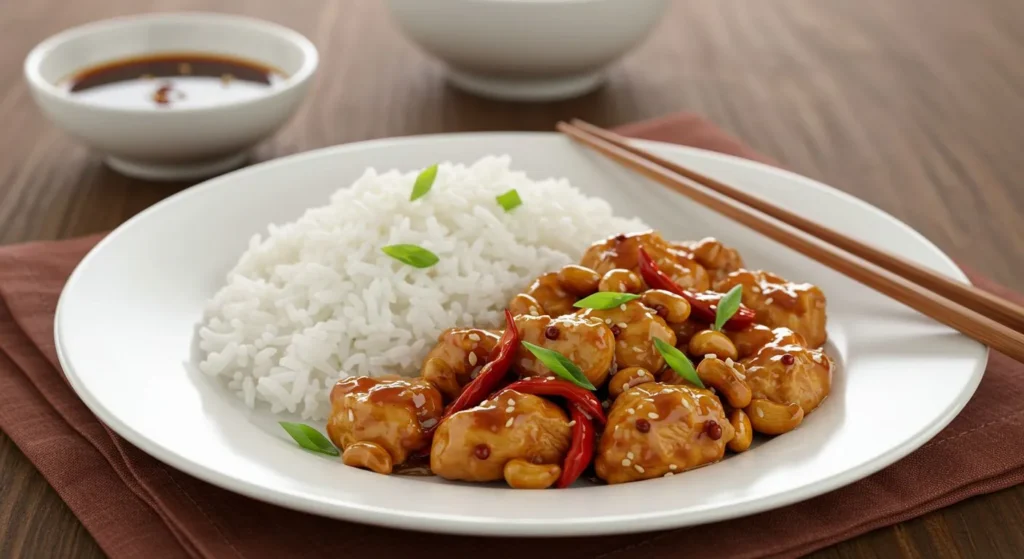
Tips for Perfect Kung Pao Chicken Every Time
To elevate your Kung Pao Chicken from good to exceptional, consider these professional tips:
1. Temperature Control is Key
- Ensure your wok is properly heated before adding ingredients. Too low a temperature will result in soggy, steamed chicken rather than the desired sear.
- If your home stove doesn’t produce enough heat, cook in smaller batches to maintain temperature.
2. Don’t Skip the Sichuan Peppercorns
- These unique peppercorns create the characteristic numbing sensation (má) that balances the heat (là) from the chilies.
- Toast and grind them fresh for the most pronounced flavor.
3. The Right Vinegar Makes a Difference
- Chinese black vinegar (Chinkiang) provides a complex, malty tanginess that can’t be replicated with other vinegars.
- If unavailable, balsamic vinegar is the closest substitute, though not identical.
4. Chicken Preparation Matters
- Velveting the chicken (marinating with cornstarch) creates the tender texture that distinguishes restaurant-quality Chinese dishes.
- Slightly undercook the chicken during the initial stir-fry, as it will continue cooking when returned to the wok with the sauce.
5. Adjust Spice Levels Thoughtfully
- For authentic flavor with less heat, remove more chili seeds rather than reducing the number of chilies.
- The dried chilies contribute essential flavor even when deseeded.
Nutritional Information
Understanding the nutritional profile of your Kung Pao Chicken can help you incorporate this delicious dish into a balanced diet:
- Calories: Approximately 350-400 calories per serving (without rice)
- Protein: 30-35g
- Carbohydrates: 12-15g
- Fat: 20-25g
- Fiber: 3-4g
- Sodium: 800-1000mg
Note that these values can vary based on specific ingredient choices and portion sizes. To reduce sodium, consider using low-sodium soy sauce and unsalted peanuts.
Variations and Adaptations
While we’ve focused on authentic preparation, Kung Pao has inspired numerous variations worth exploring:
Vegetarian Kung Pao
Replace chicken with:
- Extra-firm tofu, pressed and cubed
- Tempeh, cubed and briefly steamed
- Seitan or wheat gluten pieces
- A mixture of mushrooms such as king oyster and shiitake
Adjust cooking times accordingly, as plant proteins require different handling than chicken.
Protein Alternatives
The Kung Pao technique works beautifully with:
- Shrimp (reduce cooking time to prevent toughening)
- Beef (use tender cuts like flank or sirloin, thinly sliced)
- Pork (tenderloin works particularly well)
- Mixed seafood (adjust cooking times for each type)
 DINNER
DINNER  LUNCH
LUNCH 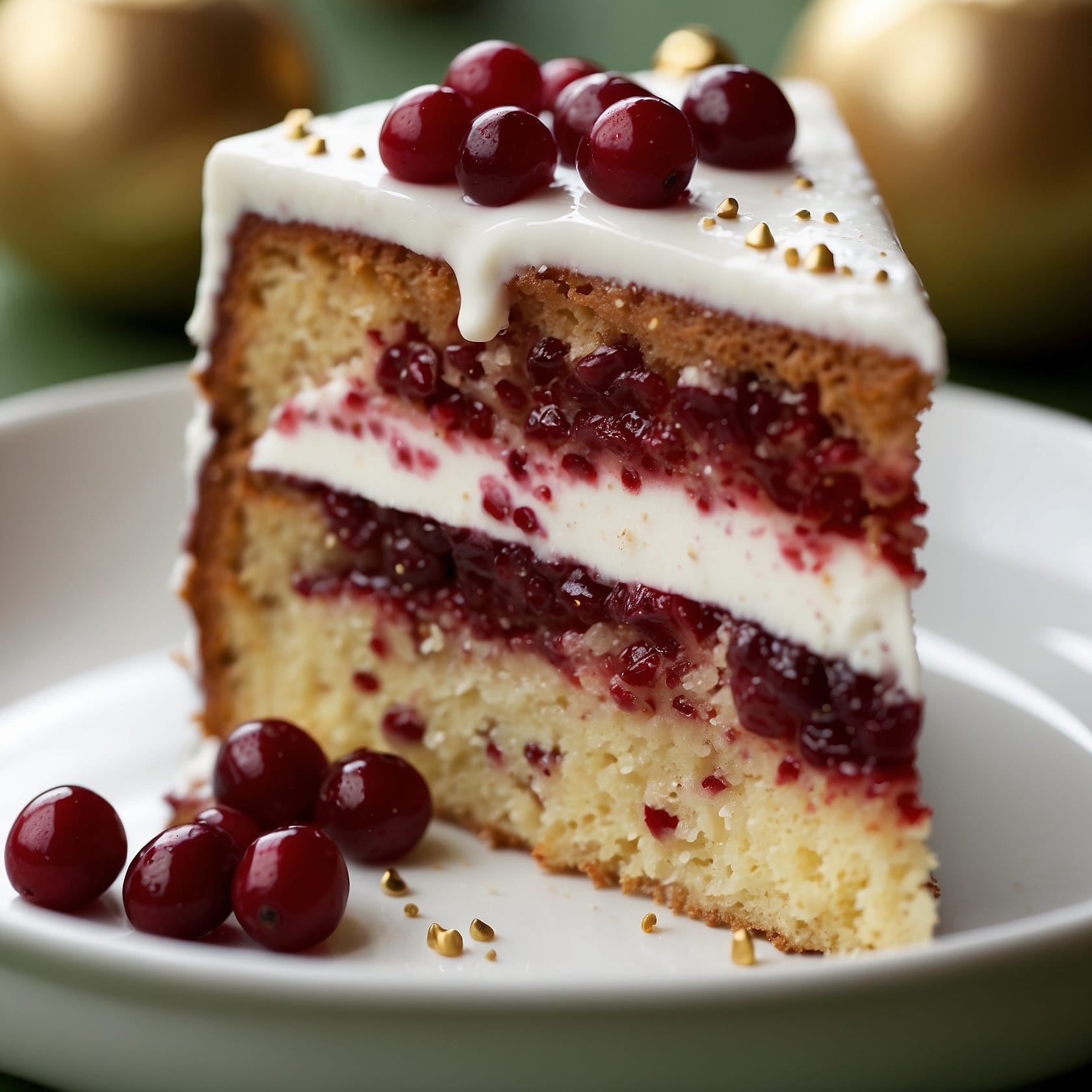 CAKE
CAKE  BREAKFAST
BREAKFAST For more amazing recipes, be sure to check out our other sections to explore a variety of ideas that will enrich your cooking experience. Each section offers its own unique flavors to ensure a delightful culinary journey:
- Easy and Quick Recipes: A collection of dishes that guarantee delicious meals with minimal effort and time.
- Healthy Recipes: Discover healthy and delicious options that fit your lifestyle.
- Desserts: A diverse selection of sweets that will add a special touch of sweetness to your table.
- Lunch Recipes: Tasty lunch ideas that you can easily prepare to delight your family.
- Dinner Recipes: Delicious and easy-to-make recipes that will make your dinner a memorable occasion.
Regional Variations
- Guizhou Style: Incorporates pickled vegetables for added tanginess
- Taiwan Style: Often includes more vegetables and sometimes cashews instead of peanuts
- American-Chinese Style: Sweeter, with more vegetables and often heavier on sauce
Pairing and Serving Suggestions
Complement your Kung Pao Chicken with these traditional accompaniments:
Side Dishes
- Steamed jasmine or short-grain rice
- Simple stir-fried greens like bok choy or Chinese broccoli
- Hot and sour soup
- Vegetable spring rolls
- Cucumber salad with garlic and vinegar
Beverages
- Chinese jasmine tea (helps cleanse the palate between bites)
- Light lager beer
- Off-dry Riesling wine
- Plum wine
- For non-alcoholic options, try chrysanthemum tea or a cooling cucumber-mint water
Storing and Reheating Leftovers
If you have leftovers (though that’s rarely the case with Kung Pao Chicken!), here’s how to handle them:
- Cooling: Allow the dish to cool to room temperature before storing, but don’t leave it out for more than 2 hours.
- Storage: Place in an airtight container in the refrigerator for up to 3 days.
- Freezing: While possible, freezing isn’t ideal as the texture of the chicken and vegetables will change. If freezing, consume within 1 month.
- Reheating: For best results, reheat in a wok or skillet over medium-high heat rather than microwave. Add a small splash of chicken stock or water if the dish seems dry.
The flavors often develop further after refrigeration, making next-day Kung Pao sometimes even more flavorful than when freshly made.
Common Mistakes to Avoid
Even experienced cooks can encounter challenges with this dish. Here are pitfalls to avoid:
- Overcrowding the wok: This reduces temperature and causes steaming rather than proper searing. Cook in batches if necessary.
- Using the wrong vinegar: Regular white or apple cider vinegar lacks the complexity needed. Invest in proper Chinese black vinegar.
- Burning the aromatics: Garlic, ginger, and especially dried chilies can burn quickly, creating bitter flavors. Watch them carefully.
- Too much sauce: Authentic Kung Pao is not swimming in sauce. It should just coat the ingredients.
- Neglecting the marinade time: The velvet-textured chicken is achieved through proper marination. Don’t rush this step.
Conclusion: Mastering the Art of Kung Pao Chicken
Kung Pao Chicken exemplifies the sophistication of Sichuan cuisine, demonstrating how seemingly simple ingredients can transform into an extraordinary culinary experience through proper technique and understanding of flavor balance. By following this comprehensive guide, you’ve gained insight into not just a recipe, but a cooking philosophy centered around harmony, contrast, and precision.
Whether you’re cooking to impress guests or simply to enjoy one of the world’s great dishes at home, authentic Kung Pao Chicken offers a rewarding cooking experience and delicious results. As you become more comfortable with the techniques involved, you’ll develop an intuitive understanding of the balance of flavors that makes Sichuan cuisine so beloved worldwide.
Remember that true mastery comes with practice, so don’t be discouraged if your first attempt isn’t perfect. Each time you prepare this dish, you’ll refine your approach and develop a deeper appreciation for the culinary traditions behind it. Enjoy the journey of bringing this iconic dish to your table, and savor the complex flavors that have delighted diners for generations.
FAQs About Kung Pao Chicken
Q: Can I make Kung Pao Chicken without Sichuan peppercorns? A: While you can make a tasty dish without them, it won’t be authentic Kung Pao Chicken, as the numbing quality they provide is essential to the málà experience. If unavailable, black pepper can be substituted, but the flavor profile will be significantly different.
Q: Is Kung Pao Chicken very spicy? A: Traditional Kung Pao Chicken is moderately spicy, but you can adjust the heat level by removing more or all of the seeds from the dried chilies. The dish should always maintain a balance between heat, saltiness, tanginess, and sweetness.
Q: What’s the difference between Kung Pao Chicken and General Tso’s Chicken? A: While both dishes feature chicken and chilies, General Tso’s Chicken is a sweet, deep-fried dish created in American-Chinese restaurants with no authentic Chinese counterpart. Kung Pao is an authentic Sichuan dish featuring stir-fried (not deep-fried) chicken, peanuts, and a more complex, less sweet flavor profile.
Q: Can I prepare any components ahead of time? A: Yes! You can marinate the chicken up to a day in advance, prepare the sauce up to two days ahead, and chop all vegetables several hours before cooking. The actual stir-frying should be done just before serving for best results.
Q: Why did my sauce not thicken properly? A: Ensure your cornstarch is fully dissolved in the sauce mixture before adding it to the wok. Additionally, the sauce needs to come to a brief boil in the wok to activate the thickening properties of cornstarch. If still too thin, mix a small amount of cornstarch with cold water and add to the wok, bringing to a boil again.
